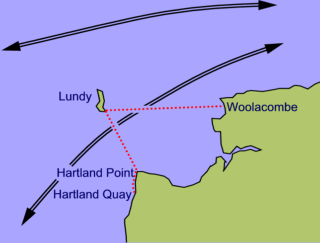A windy day between Hartland Quay and Hartland Point on the Atlantic coast of England. "The Romans called it the Point of Hercules. They felt, I think, that when they rounded it they were coming into another sea... within Hartland you are under the wing of England and in homely water. Outside Hartland you have all the West before you and the power of Ocean".
Hilaire Belloc, The Cruise of the Nona, 1925
Adjusting your plot for wind
A wind blowing from directly ahead will slow you down. If it blows from the side it will push you sideways. This is called leeway and it is hard to calculate the rate of drift. If you are stationary then a wind of Force 3 on the Beaufort Scale blowing from one side may push you sideways at 1.5 knots. In a Force 5 your sideways drift may be 2 knots. See Leeway for a discussion.
If you can see your destination you can use ranges to ensure that you go straight there. If poor visibility means that you can't see your destination but you can still see your departure point, you can use your compass to check whether you are still on course.
Sea kayakers very, very seldom make open-water crossings without being able to see their destination. However, let's say you want to make a long crossing to an island to the east of you. One thing after another has gone wrong and you now have no choice but to make the crossing in visibility so bad that most of the way you will be able to see neither your departure point nor your destination. The only real way to calculate the speed of your sideways drift would be with a GPS satellite navigation device, but you don't have one. You are asking yourself how the heck you managed to get into such a dangerous situation. You are steering by compass on a course which you earlier calculated as 75 degrees magnetic. There is no significant tidal current. You did not adjust for wind. You are taking it easy and going at 2.6 knots. The wind is Force 3 from the side, and as a result your real course is something like 20 degrees downwind of the direction in which your kayak is pointing (red line). You are going to miss the island by such a large margin that you will go past it without hearing or seeing it.

If you really have no choice but to make this crossing, you could greatly improve your chances of finding the island by adjusting your course for wind. In the same way that you can draw tidal triangles, you can draw a wind triangle to calculate the direction in which to point your kayak. You know your course if there were no wind, and you know your own speed. You know the direction the wind was blowing. The only other figure you need is an estimate of the speed of your sideways drift. That is very hard to assess and depends on your kayak, your paddle, the load you're carrying, whether you have your skeg down, the sea state, and so on. In this example we'll say that your heading should be 55 degrees. The wind triangle will also tell you after how many hours/minutes you should start listening and looking for any sign of the island.
Aiming off
If you make an open water crossing, wind and currents may push you off course. In poor visibility or where your target is on a coast which lacks clear landmarks, you may reach the coast unsure whether you are to the left or the right of your final destination. Consider deliberately aiming to the left or the right, so that you know which way to turn when you reach the coast.


 The main current flows eastwards up the Bristol Channel for six hours (until four hours before high water at Dover, as it happens), and then flows the other way for six hours until low tide. On the day of our trip the tidal streams between Lundy and Devon will flow at a maximum of 3 knots.
The main current flows eastwards up the Bristol Channel for six hours (until four hours before high water at Dover, as it happens), and then flows the other way for six hours until low tide. On the day of our trip the tidal streams between Lundy and Devon will flow at a maximum of 3 knots. 


